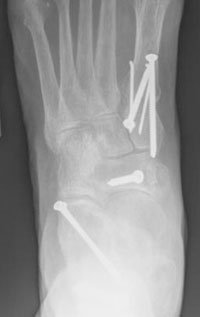Spring ligament reconstruction corrects flatfoot deformity without arthrodesis
KEYSTONE, Colo. — A spring ligament reconstruction, done at the time of the initial surgery, can help patients with severe flexible flatfoot deformity and posterior tendon deficiency who would otherwise fail correction with calcaneal osteotomy and lateral column lengthening alone, and therefore require fusion in the hindfoot, according to a study presented by Jonathan T. Deland, MD, at the 2011 Annual Meeting of the American Orthopaedic Foot & Ankle Society.
“In the operating room, after doing medial slide osteotomy and lateral column lengthening, it was apparent that we did not give enough correction, and the surgery would fail in these people with severe flexible flatfoot deformity,” Deland said during his presentation.
To determine the outcomes of spring ligament reconstruction, Deland and colleagues performed the procedure on 13 patients (14 feet) with spring ligament ruptures who failed to correct their flatfoot deformities in the operating room using medial slide osteotomy and lateral column lengthening. The patients had a mean age of 64 years and were followed for a mean of 8.9 years. The researchers assessed patient outcomes using weightbearing radiographs and the Foot and Ankle Outcome Score (FAOS), AOFAS and SF-36 scores. They also evaluated the patients’ hindfoot alignment and eversion strength.
|
|
Images: Deland J T |
The investigators found that the AOFAS scores increased from 43.1 preoperatively to 90.3 postoperatively. In addition, the FAOS pain subscale measured 83.7 points and SF-36 score averaged 77.3 points at follow-up. The lateral talonavicular, anteroposterior first tarsometatarsal and talonavicular-coverage angles stabilized to normal levels postoperatively. The mean postoperative hindfoot alignment was 2.7· valgus. All but one patient regained normal eversion strength, Deland said. None of the patients required a triple arthrodesis, and they all gained adequate correction with motion remaining in the triple joint complex.
“Where a posterior calcaneal osteotomy and lateral column lengthening would fail, the addition of the spring ligament reconstruction can allow the patient to avoid a triple arthrodesis,” Deland said. “The next step in my research is to apply the spring ligament reconstruction technique to lessen the amount or need of lateral column lengthening.” – by Renee Blisard
References:
- Deland JT. Spring ligament complex in flatfoot deformity: Cure or blessing? Presented at the 2011 Annual Meeting of the American Orthopaedic Foot & Ankle Society. July 13-16. Keystone, CO.
- Williams BR, Ellis SJ, Deyer TW, Pavlov H, Deland JT. Reconstruction of the spring ligament using a peroneus longus autograft tendon transfer. Foot Ankle Int. 2010; 31(7):567-577.

- Jonathan T. Deland, MD, can be reached at the Hospital for Special Surgery, East River Professional Building, 523 E. 72nd St., 5th Floor, New York, NY 10021; 212-606-1665; email: delandj@hss.edu.
- Disclosure: Deland receives consulting fees from Zimmer, Arthrex and Tornier, and has intellectual property rights or is a patent holder for Arthrex and Zimmer.











